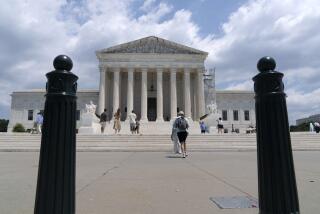Students Can Put Hands Over Their Hearts, or Their Ears
- Share via
Are children psychologically frail and incapable of deciding whether they truly wish to go along with a crowd? Or are they morally sturdy and independent, much like little Stoics?
Most people would say they cannot be both, but the Supreme Court has characterized them in both ways over the last 60 years.
These conflicting images have emerged as the court has decided how much free speech is too much free speech for the eyes and ears of the young. And the court ought to take account of these contradictions early next year in the case of Elk Grove Unified School District vs. Michael Newdow et al -- the Pledge of Allegiance case.
The court will decide whether a policy that has teachers leading willing students in the pledge in public school violates the 1st Amendment’s prohibition of laws “respecting an establishment of religion.”
For several reasons, the court should uphold the daily recitation of the pledge.
Previous decisions allow us to predict the court’s approach here. In all likelihood, the justices will ask whether reciting the pledge has an “indirectly coercive” effect on students disinclined to participate in the exercise.
The theory of indirect coercion, which the court has been developing since the 1940s, stresses that the 1st Amendment’s establishment clause may be violated even without direct pressure to participate in a public ceremony of prayer or thanksgiving.
Proponents of the theory say that the willing participation of adults and other children leads some reluctant or indifferent children to join in. Proponents also hold that children may suffer real (though unspecified) psychological damage through such participation.
Indirect coercion was a key variable in Lee vs. Weisman in 1992. There the court ruled that the establishment clause was violated when a rabbi delivered a benediction to graduating seniors at a public high school in Rhode Island.
The court argued that the act of standing in respectful silence -- a widespread convention at such ceremonies -- could be construed as an “endorsement” of the rabbi’s message, leaving the “dissenting” student in a morally untenable position.
But the court should also look at those cases in which it characterized children as being far more resilient. In Cohen vs. California (1968), Erznoznik vs. City of Jacksonville (1975) and United States vs. Playboy Entertainment Group Inc. (2000), the court secured free speech rights for adults even though children were exposed to a four-letter epithet on a man’s jacket, full-frontal nudity at a drive-in movie and hard-core pornography on cable television.
For most of American history such kinds of communication had little constitutional protection, but in these cases the court concluded that the free speech rights of adults outweighed the social interests in sparing children exposure to such things.
In reaching this conclusion, the court emphasized that all persons -- including the young -- remained free to “avert their eyes.”
That raises a large question for Newdow’s suit: Daily exposure to the Pledge of Allegiance may offend some students and their parents, but why should the rights of the offended prevail over the rights of the students who want to say the pledge? After all, the 1st Amendment protects many types of speech, and if the court wants young people to avert their eyes in one context, students could do the same (and block their ears) in this situation.
But does this argument give short shrift to the establishment clause? And does the setting -- a public school -- make an important difference?
It is difficult to maintain that merely reciting a text with a reference to a deity is “a law respecting an establishment of religion,” even if the recitation occurs at a public school. To hold otherwise would mean that the Declaration of Independence cannot be recited as a civic exercise there, since the Declaration expressly refers to our “Creator.”
Could anyone accept that conclusion? Are such references “coercive” in the usual sense of the word? The court should shun the theory of indirect coercion. The theory is justified when applied to indisputably religious exercises, but the circumstances here are different. Additionally, the theory has lost some of its force because the court failed to apply it in free speech cases like those mentioned above. So barring genuine compulsion in a classroom, the court should affirm the freedom of students and teachers to recite the pledge.
More to Read
Sign up for Essential California
The most important California stories and recommendations in your inbox every morning.
You may occasionally receive promotional content from the Los Angeles Times.










